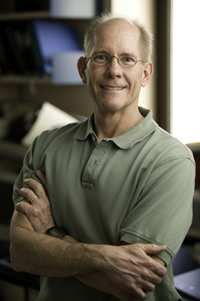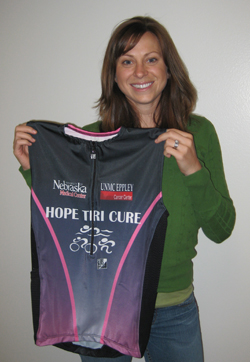 Outside the laboratory, Tony Hollingsworth, Ph.D., has run, swam and cycled hundreds of miles during the past year.
Outside the laboratory, Tony Hollingsworth, Ph.D., has run, swam and cycled hundreds of miles during the past year.
But, on Saturday, the UNMC researcher will do it all in one day when he competes in the Ironman Florida triathlon.
Participants have 17 hours to complete the event, which consists of a 2.4 mile swim, 112 mile bike ride and 26.2 mile run.
 |
UNMC’s Tony Hollingsworth, Ph.D., will compete this weekend in a triathlon in Florida to raise funds and awareness for cancer research. |
Dr. Hollingsworth and UNMC graduate student Jennifer Bailey Lundberg are part of the 11-member “Tri to Cure Cancer” team that will participate in the Florida triathlon and raise awareness and funds for cancer research.
The team, made up of a group of individuals with Nebraska ties, includes Omahan Marianna Phipps, who in 2005 won the women’s 60-64 age division and set a world record in Kona, Hawaii, at the Ironman World Championship.
Lundberg, who ran an Ironman triathlon in Wisconsin two years ago, admits this is an “extreme form of exercise,” but says it’s important that individuals find activities that challenge and motivate them.
Wellness doesn’t require marathon runs and hours of cycling, she said.
“I’d encourage others to set goals that help them maintain a level of fitness and motivation to stay healthy,” Lundberg said. “When you challenge yourself it also enables you to encourage others to be the best they can be.”
Dr. Hollingsworth said the dual purpose of the event — both the physical challenge and the cancer awareness/fundraising focus — convinced him to participate in his first Ironman.
Donations to the “Tri to Cure Cancer” team will be used to fund new seed grants in support of cancer research projects at the UNMC Eppley Cancer Center.
On the team’s Web site, Dr. Hollingsworth describes himself as one who “swims slower than a frog, bikes faster than a tractor and runs slightly faster than a walk.”
 |
UNMC graduate student Jennifer Bailey Lundberg also will compete in the triathlon this weekend. |
“You have to set aside time to do it to develop your slow-twitch muscles,” he said.
These muscle cells — used in endurance activities such as long-distance running, cycling or swimming — contract slowly and are resistant to fatigue.
Whether its an Ironman or neighborhood basketball game, Dr. Hollingsworth simply encourages individuals to find an activity and get started.
“Don’t hesitate,” he said. “The hardest part is to get started.
“I never thought I would be in a position where I could run a half marathon or cycle 70 to 80 miles and not consider it to be that difficult,” Dr. Hollingsworth said. “Getting to that level of fitness didn’t take that much and it’s surprising and pleasant to achieve that level of fitness.”
Lundberg trained seven months for the triathlon with early morning swims and bike rides three or four times a week. She saved her longest rides of 80 to 110 miles for weekends and also incorporated a marathon-training program into her schedule.
“It’s a big sacrifice to do this,” she said. “The first time the payoff was setting the goal and completing something I honestly didn’t think I could do. This time the cancer goal is the focus.”
But, the training also reinforces the importance of healthy living.
“It makes me realize I really am busy, but if you want to make fitness a part of your lifestyle you will make time for it,” she said. “Exercising promotes a positive attitude and enthusiastic spirit.”
Lundberg especially enjoys the running portion of any triathlon and the “sense of community” that’s fostered on the course. As with any exercise endeavor, however, she said it’s important to “listen to your body.”